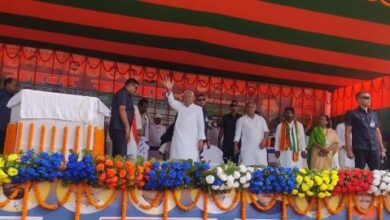Shinzo Abe, key figure in enhancing Indo-Japan ties

New Delhi, July 8 (UNI): Former Japan prime minister Shinzo Abe, who was shot dead on Friday, remains one of the key figures in enhancing Indian-Japan relations, and the creation of the grouping with US, India, and Australia, which came to be known as QUAD.
Abe, Japan’s longest serving prime minister, stepped down in 2020 due to poor health. Abe held the post of PM between 2006-07, and again from 2012, till he resigned in 2020.
As the news of Abe being shot broke, Prime Minister Narendra Modi, whose association with Abe goes back to when he was Gujarat chief minister, tweeted saying he was “deeply distressed” to learn about the attack on his “dear friend”. Former PM Manmohan Singh, who also had close ties with Abe, also issued a statement expressing shock at the incident.
As it was reported that Abe is no more, PM Modi announced a day-long state mourning, and also recalled how their association went back to his days as Gujarat CM, and appreciated Abe’s “sharp insights on economy and global affairs”.
QUAD, a strategic security dialogue between Australia, India, Japan, and the United States, was initiated in 2007 by Abe. The four countries also started a quadrilateral exercise Malabar, setting cautious steps as China raised concerns.
Australia, however, later withdrew, and the QUAD collapsed. It was however revived a decade later, and in 2017, the four countries once again agreed to revive the quadrilateral alliance in order to counter China militarily and diplomatically in the “Indo-Pacific” region, particularly in the South China Sea.
While India and Japan enjoyed good ties historically. In 1951, Jawaharlal Nehru had refused to sign the San Francisco Treaty, as he considered it to be limiting Japanese sovereignty. In 1952. The Treaty of Peace Between Japan and India was later signed in 1952 restoring relations between the two nations.
The efforts to improve relations with India were visible since Abe’s first, short stint in the PM’s office. In 2007, he visited India and became the first Japanese PM to address a joint sitting of Indian Parliament. In his historic speech, Abe referred to Swami Vivekananda, Mahatma Gandhi, Dara Shikoh, and talked about the historical ties between the two Asian nations.
In 2011, during another visit to India, at a speech at the Indian Council of World Affairs, Abe had again stressed on strong bilateral ties, and had also talked about India’s first PM Jawaharlal Nehru, who had hosted Abe’s maternal grandfather and then Japanese PM Nobusuke Kishi in New Delhi in 1957.
In 2014, Abe was the first Japanese PM to be the Chief Guest at the Republic day parade. He also visited India in December 2015, and September 2017.
In 2021, Abe was awarded India’s second-highest civilian award Padma Vibhushan for his seminal contributions to Indo-Japanese relations.
In May this year, PM Modi had met Abe, and former Japanese Prime Minister Yoshiro Mori, the chairperson of Japan-India Association (JIA). Abe was to be the next JIA chief. His death was condoled by the government, as well as Opposition leaders in India.
Congress leader Rahul Gandhi also remembered his contribution to India-Japan bilateral ties. “Deeply saddened by the demise of former PM of Japan, Shinzo Abe. His role in strengthening the strategic relationship between India & Japan was commendable. He leaves behind a lasting legacy in the Indo-Pacific. My condolences to his family & to the people of Japan,” said the Congress leader.





